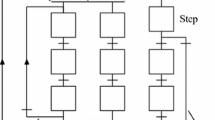Conclusions
-
1.
The intensity parameter of metrological failures is generally a nonlinear function of the allowance band. As the allowance band is widened, the metrological reliability of instruments increases, and vice versa.
-
2.
In the case of electronic regulators, a widening of the allowance bands by 50% reduces the failure intensity of type RPIK-III instruments 1.6 times, of type RPIB-T instruments 2.7 times, and of type RPIB-III instruments 17 times.
-
3.
An analysis of the correlation between the mean operating time without failure (considering metrological failures only) and the width of the allowance band has shown that the likelihood of this correlation for each type of instrument investigated is better than 0.999.
-
4.
According to the studies made, in several technological processes where high-accuracy (class 0.5 or 1.0) instruments are used but where 1.5–4.0% accuracies are adequate for the process reliability, the reliability and the life of such instruments can be increased considerably and the unfulfilled demand for them can be curtailed by way of requalifying them to a lower accuracy class.
-
5.
Based on the analysis of the correlation between the mean operating time without failure and the accuracy class of instruments, which was carried out using 2858 units of six different accuracy classes (from 0.5 to 4.0) and considering accidental failures only, one may state that also in terms of accidental failures does the correlation between the accuracy and the reliability of the tested instruments exist with a high likelihood (over 0.9999): instruments of higher accuracy classes are less reliable than less accurate and less sensitive instruments.
Similar content being viewed by others
Literature cited
GOST 13377-67, Reliability in Engineering: Terminology (1967).
B. S. Ivanov, T. A. Yarotskaya, and P. B. Rubinshtein, Stand. a. qual., No. 4 (1967).
S. A. Aivazyan, Statistical Analysis of Functions Relations [in Russian], “Metallurgiya,” Moscow (1968).
Approximate Methods of Combined Economic and Statistic Evaluation of Mass Production Quality [in Russian], “Statistika,” Moscow (1967).
I. V. Dunin-Barkovskii and N. V. Smirnov, Theory of Probability and Mathematical Statistics in Engineering (general part) [in Russian], Gostekhizdat, Moscow (1955).
B. S. Ivanov and T. A. Yarotskaya, NIITeplopribor symp., Nos. 3–4, Moscow (1967).
Additional information
Translated from Izmeritel'naya Tekhnika, No. 5, pp. 76–78, May, 1970.
Rights and permissions
About this article
Cite this article
Ivanov, B.S., Svecharnik, D.V. Relation between the accuracy and the reliability of certain thermo-energy type of instruments. Meas Tech 13, 748–752 (1970). https://doi.org/10.1007/BF01409135
Received:
Issue Date:
DOI: https://doi.org/10.1007/BF01409135




